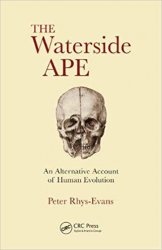The Waterside Ape : An Alternative Account of Human Evolution
- Добавил: TRex
- Дата: 22-04-2022, 18:06
- Комментариев: 0
 Название: The Waterside Ape : An Alternative Account of Human Evolution
Название: The Waterside Ape : An Alternative Account of Human EvolutionАвтор: Peter H. Rhys Evans
Издательство: CRC Press
Год: 2020
Формат: PDF
Страниц: 250
Размер: 29 Mb
Язык: English
A savannah scenario of human evolution has been widely accepted primarily due to fossil evidence; and fossils do not offer insight into these questions. Other alternative evolutionary scenarios might, but these models have been rejected. This book explores a controversial idea – that human evolution was intimately associated with watery habitats as much or more than typical savannahs. Written from a medical point of view, the author presents evidence supporting a credible alternative explanation for how humans diverged from our primate ancestors. Anatomical and physiological evidence offer insight into hairlessness, different coloured skin, subcutaneous fat, large brains, a marine-type kidney, a unique heat regulation system and speech. This evidence suggests that humans may well have evolved, not just as savannah mammals, as is generally believed, but with more affinity for aquatic habitats – rivers, streams, lakes and coasts.
Key Features:
- Presents the evidence for a close association between riparian habitats and the origin of humans
- Reviews the 'savannah ape' hypothesis for human origins
- Describes various anatomical adaptations that are associated with hypotheses of human evolution
- Explores characteristics from the head and neck such as skull and sinus structures, the larynx and ear structures and functions
- Corroborates a novel scenario for the origin of human kind
‘… a counterpoint to the textbooks or other books which deal with human evolution. I think readers will see it as a clearly written, well-supported discussion of an alternativeperspective on human origins'. —Kathlyn Stewart, Canadian Museum of Nature, Ottawa
‘There is a pressing need to expand discussions of human evolution to includenon-anthropocentric narratives that use comparative data. Dr Rhys-Evans' specific expertise and experience with the human head, neck, ears, throat, mouth and sinuses, provides him with a distinct perspective from which to approach the subject of human evolution. Moreover, his understanding of non-anthropocentric views of human evolution (water-based models), allow him to apply a biological approach to the subject, missing in more traditional (savannah-based) models'. —Stephen Munro, National Museum of Australia
Внимание
Уважаемый посетитель, Вы зашли на сайт как незарегистрированный пользователь.
Мы рекомендуем Вам зарегистрироваться либо войти на сайт под своим именем.
Уважаемый посетитель, Вы зашли на сайт как незарегистрированный пользователь.
Мы рекомендуем Вам зарегистрироваться либо войти на сайт под своим именем.
Информация
Посетители, находящиеся в группе Гости, не могут оставлять комментарии к данной публикации.
Посетители, находящиеся в группе Гости, не могут оставлять комментарии к данной публикации.
